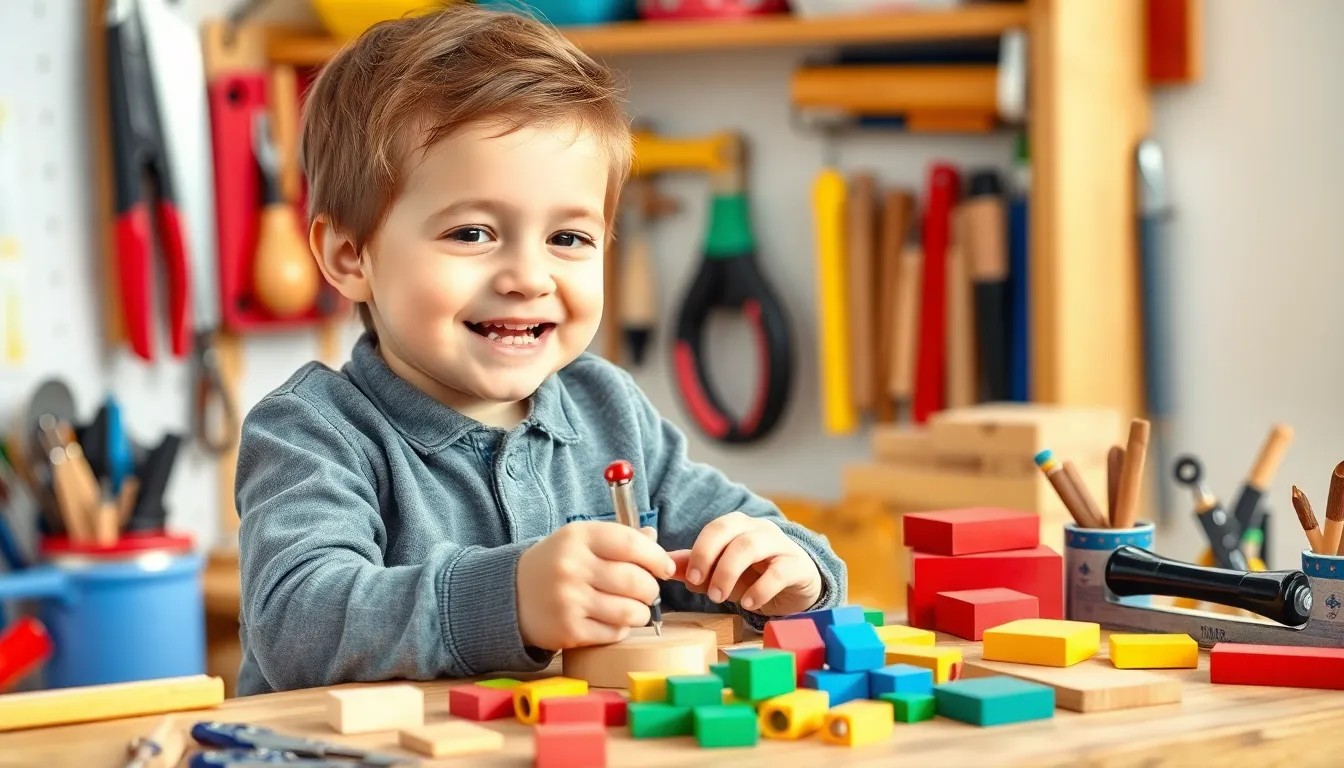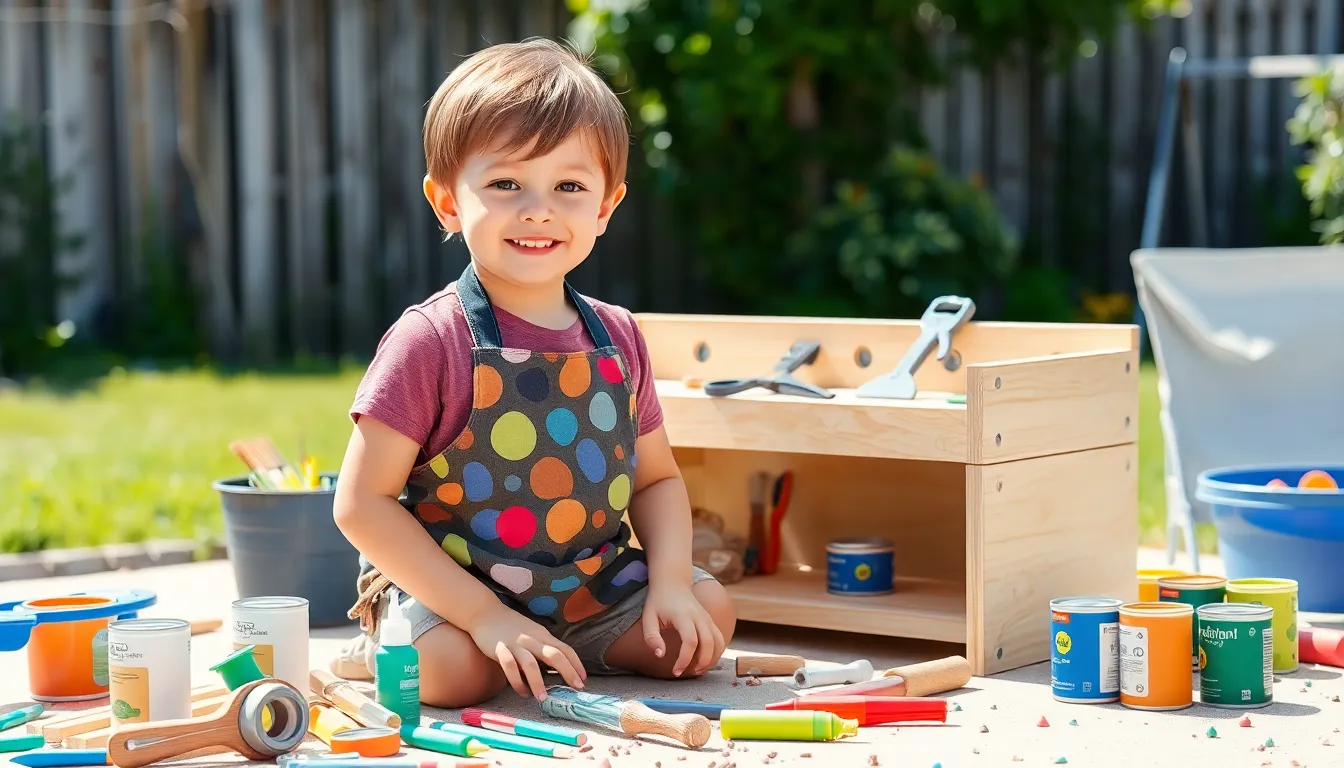Table of Contents
ToggleEvery little builder dreams of having their own tool bench, and why not? It’s the perfect playground for creativity, imagination, and maybe a little chaos. A DIY kids tool bench isn’t just a project; it’s a gateway to hours of fun and learning. Who wouldn’t want to see their child channel their inner carpenter while wielding a toy hammer like a pro?
Overview of DIY Kids Tool Bench
A DIY kids tool bench serves as an ideal platform for sparking creativity. It allows children to explore their imaginative abilities in a safe and constructive environment. Parents find that building a tool bench together not only fosters bonding but also teaches essential skills. Projects can include assembling tool holders, cutting boards, and storage compartments.
Materials needed for construction typically include wood, screws, and paint. When choosing wood, opting for child-safe, non-toxic finishes ensures a safe play area. Additionally, involving kids in the selection of colors can enhance their sense of ownership.
Design flexibility matters, as each tool bench can cater to the child’s preferences. Parents can customize size and height to accommodate different ages. Including a variety of tools such as hammers, screwdrivers, and wrenches engages children in role-play that mimics real-life actions.
Educational benefits exist beyond play. Children develop fine motor skills through gripping, hammering, and assembling components. Problem-solving becomes a natural part of play as they navigate tool usage and project challenges. They gain confidence while completing tasks, reinforcing their ability to take on new challenges.
A DIY kids tool bench combines fun with learning. It supports creativity, promotes practical skills, and encourages exploration. By investing time in this project, parents provide a lasting tool that nourishes imaginative play and practical understanding.
Benefits of DIY Tool Benches for Kids

Creating a DIY tool bench provides numerous benefits for children. These projects not only engage their interests but also foster valuable skills.
Encouraging Creativity
A DIY tool bench offers an outlet for children’s imaginations. They explore different designs and customize features to reflect their unique styles. By selecting colors and arranging tools, children express themselves in a meaningful way. Engaging in role-play scenarios further stimulates their creativity, as they envision projects and tasks. Each child’s imagination flourishes through the hands-on nature of this activity, inviting inventive thinking. The experience of constructing a tool bench nurtures a sense of ownership and pride in their creations.
Enhancing Motor Skills
Building a tool bench enhances children’s fine motor skills significantly. They practice using tools like screwdrivers and hammers, which improves hand-eye coordination. Tasks involve grasping, twisting, and maneuvering, leading to stronger dexterity in their fingers. As children assemble parts, they also develop problem-solving abilities by figuring out how pieces fit together. Completing projects boosts their confidence, encouraging them to tackle future challenges. Every time children engage with their tool bench, they refine their skills further, laying a foundation for future hands-on activities.
Essential Materials for Building a Tool Bench
A sturdy tool bench requires the right materials for construction. Selecting quality components ensures a safe and functional play space for kids.
Recommended Wood Types
Pine stands out as a popular choice due to its lightweight nature and affordability. Maple, known for its durability and smooth finish, offers a more robust option. Oak provides added strength and resistance to wear, making it suitable for heavy use. Selecting wood that’s free from knots and defects guarantees safety. For outdoor play, treated lumber enhances weather resistance.
Tools Needed
Parents should gather essential tools before starting the project. A saw aids in cutting wood to desired dimensions. A drill makes assembling the bench easier with screws. Sandpaper helps smooth rough edges, ensuring safe play. Measuring tape allows accurate size adjustments during construction. Clamps secure pieces together while tightening screws. It’s advisable to include a level to ensure the bench sits evenly.
Step-by-Step Guide to Creating a DIY Kids Tool Bench
Creating a DIY kids tool bench involves simple steps that allow for creativity and learning. Below are essential processes in building this engaging project.
Designing Your Tool Bench
Begin with sketching the design on paper. Size considerations are crucial; it should match the child’s height for optimal use. Incorporating storage elements enhances functionality, allowing kids to organize tools efficiently. Choose colors that reflect the child’s preferences, as this fosters a sense of ownership. These design choices support imaginative play and encourage children to explore their creative sides.
Assembling the Components
Gather the essential materials and tools before starting assembly. Start by cutting the wood according to the measurements from the design. Afterward, use screws and a drill to attach the legs to the work surface securely. Incorporate storage options such as shelves or compartments during this phase. Ensure that parents supervise the process for safety. Place each component carefully, checking alignment with a level for stability.
Adding Finishing Touches
Focus on safety when applying paint or finish. Select non-toxic, child-safe options to protect little hands. After painting, sand down any rough edges for smoothness. Accessorize the tool bench by adding plastic tools and a pegboard for organization. Enhance visual appeal by incorporating fun designs or patterns. These finishing touches not only beautify the bench but also enrich the play experience while ensuring it remains a safe space for children.
Creative Ideas for Customization
Customizing a DIY kids tool bench sparks imagination uniquely. Start by integrating colorful paint themes that reflect the child’s personality. Opt for non-toxic colors to ensure safety while allowing kids to pick their favorites.
Adding personalized features enhances their connection to the project. Consider attaching their name or initials to the bench, creating a sense of ownership. Incorporating magnetic strips or tool holders offers additional organization, making playtime smoother and helping kids learn about tidiness.
Select adjustable heights for the work surface to accommodate growth. This adaptability extends the bench’s usability over time, allowing it to evolve with the child. Consider including pegboards for versatile storage options, where kids can hang tools and accessories easily.
Creating themed sets can add an exciting play element. Choose themes like construction, gardening, or even veterinary care, with tools representing each trade. Incorporating small vocational outfits, such as aprons or hats, enhances imaginative play while making the experience authentic.
For a tactile experience, integrate various textures. Soft foam or rubber mats can provide comfort while ensuring safety during play.
Including a dedicated space for arts and crafts encourages creativity alongside tool usage. Design compartments to hold art supplies like markers, scissors, and paints.
Hide secret compartments or surprise drawers within the bench for added fun. Kids appreciate the thrill of discovery, making their workbench an adventure hub.
Finally, collaborating with kids on customization enhances learning. Inviting them to brainstorm ideas fosters creativity and strengthens problem-solving skills, creating not only a tool bench but also a memorable experience.
Creating a DIY kids tool bench is a rewarding project that combines fun and education. It not only allows children to engage in imaginative play but also helps them develop essential skills like problem-solving and fine motor coordination. The hands-on experience fosters creativity and a sense of ownership, making the tool bench a cherished addition to their playtime.
By involving kids in the design and customization process, parents can strengthen their bond while nurturing their child’s individuality. This project serves as a foundation for future hands-on activities and practical learning experiences, ensuring that children can explore their interests in a safe and supportive environment. A DIY kids tool bench truly is a gateway to endless adventures and creativity.




